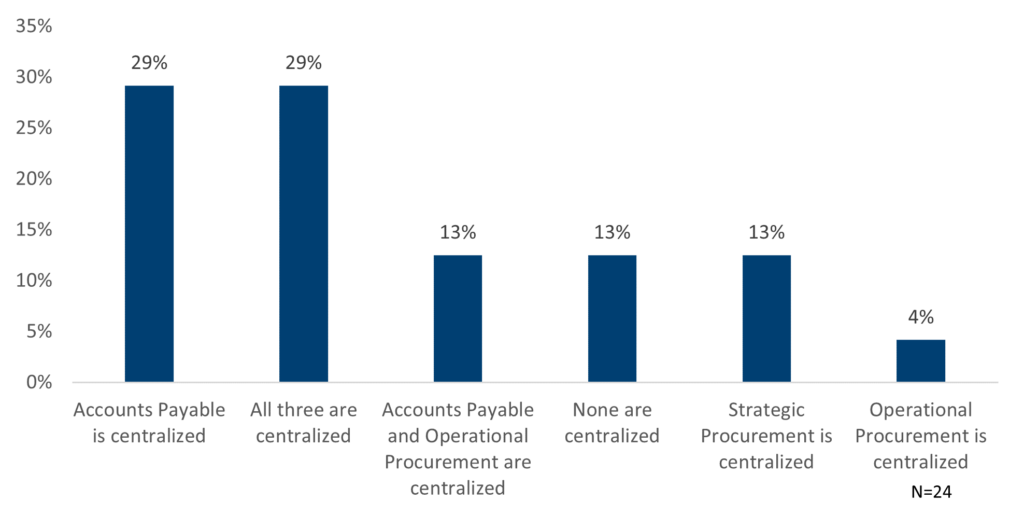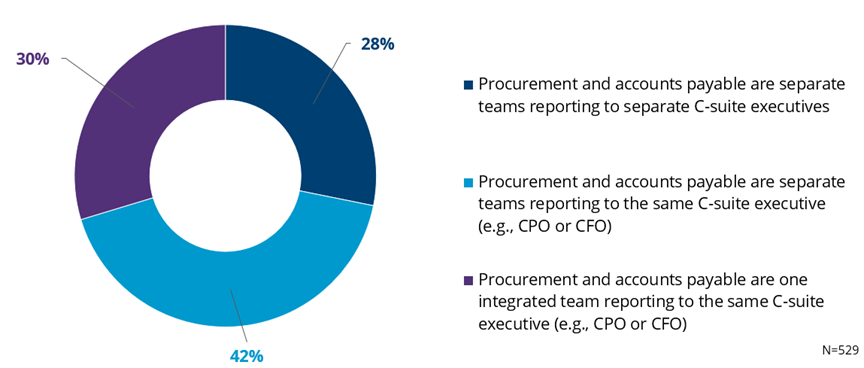
End-to-end processes like procure-to-pay (P2P) transcend business silos and functional boundaries. To coordinate the work of separate functions across the entire value chain, leading organizations centralize governance of the end-to-end process in a single process owner. This governance structure helps ensure that activities like measurement, process standardization, and process improvements all work in service of the larger end-to-end process.
In October 2021, APQC hosted Trey Robinson and John Francis (partners and supply chain co-leads) from ScottMadden for a webinar to discuss leading practices in procurement transformation. In their webinar, Robinson and Francis described global process ownership as part of a broader shift toward more strategic service delivery in procurement. Centralization and global process ownership for P2P help ensure that organizations take a balanced approach to developing key procurement capabilities like responsive customer service and impactful sourcing strategies.
Access the complete article series here.
Beginning in the mid-to late-2000s, the emphasis on procurement shifted in many organizations, from administrative and transactional activities to strategic activities. This shift toward strategic procurement “aligns the organization to the work being performed in a way that efficiently delivers service while also reaping the rewards of strategic buying, category management and improved productivity, efficiency, and technology enablement,” according to Francis. As part of this shift, procurement groups “have started to understand their impacts on accounts payable (AP),” which has led both procurement and AP to move toward an end-to-end P2P process.
To coordinate process improvement activities like standardization and gain visibility over the entire value chain, leading organizations centralize governance of end-to-end processes like P2P by identifying a single process owner. The ideal process owner will have strong soft skills, including bringing people together across the enterprise to optimize and improve the end-to-end process. Coordination through a single owner makes standardization, process measurement, and other process management initiatives much more seamless. As Francis explained, centralized governance “drives a stronger mandate toward standardization of policies and processes while retaining a separate organization to execute the day-to-day operations.”
One important benefit of centralization is that it enables organizations to strike a good balance between strategic and operational facets of procurement. Francis said that leading procurement organizations seek a balanced approach across three key procurement capabilities:
Many organizations focus on one of these areas at the expense of the other two. For example, some organizations focus heavily on advancing their skills to adopt category management, while taking for granted the importance of operational procurement’s impact on customer service and strategic procurement’s impact on finding value. Centralization through a single process owner is the best governance structure for breaking down silos and achieving a healthy balance of focus among these three areas.
Francis polled webinar participants to identify the extent to which strategic procurement, operational procurement, and accounts payable are centralized. The results of the poll indicate that many organizations are managing these areas in silos and missing opportunities to achieve the benefits that come with centralized governance of P2P (Figure 1). Less than one-third of respondents (29 percent) have all three areas centralized.
Which of the following functions are centralized?

Beyond centralization, it is also important to structure the relationship between finance (the typical parent organization of AP) and supply chain (the typical parent organization of procurement) from a reporting perspective. In organizations where procurement and AP operate as separate teams, there is often a common global process owner across P2P, even if the functions report to separate executives.
Slightly fewer than a third of respondents in APQC’s Procure-to-Pay: Structure and Automation research (30 percent) reported that procurement and accounts payable are one integrated team reporting to the same C-suite executive. Another 42 percent reported that while procurement and AP are separate teams, they still report to the same executive.
Relationship Between Procurement and AP

It is also important to choose the right reporting relationships and structures for end-to-end process owners. Robinson noted that in many leading organizations, transformation or process design and improvement is separate from process execution. The end-to-end process owner is responsible for end-to-end process design, metrics, process improvement, and continuous improvement. The end-to-end process owner does not report to the person responsible for the execution of the process, “but rather to a different person within the organization that is responsible for the end-to-end upstream and downstream design. Typically, they would report to a head of shared services in a shared services organization, but they may also report to a governance board or committee that oversees the model.”
End-to-end processes like P2P have many moving parts that transcend organizational silos. Getting the right governance and reporting structures in place is critical for coordinating process management activities across functions, balancing investments in strategic procurement capabilities like category management, and ensuring that process improvements do not damage upstream or downstream processes. More broadly, these governance structures provide a strong foundation upon which organizations can build new and more effective models for procurement service delivery.
View MoreSussex Economic Advisors is now part of ScottMadden. We invite you to learn more about our expanded firm. Please use the Contact Us form to request additional information.